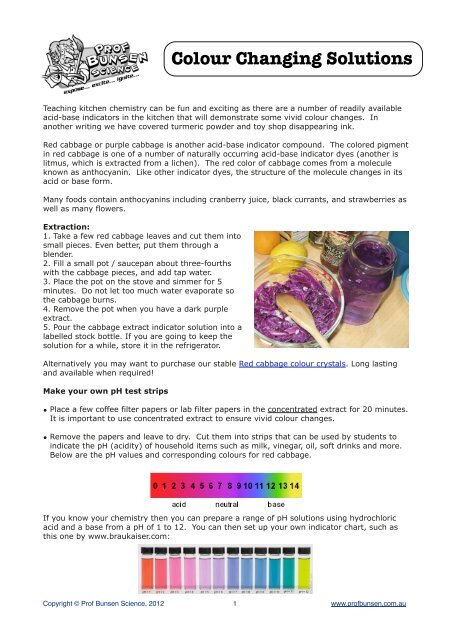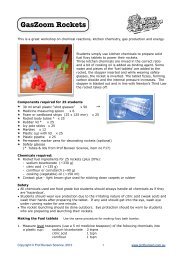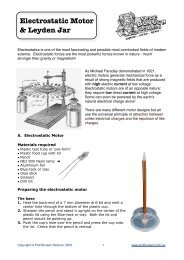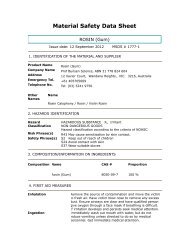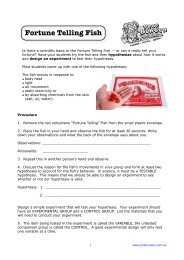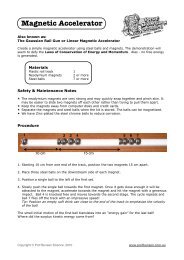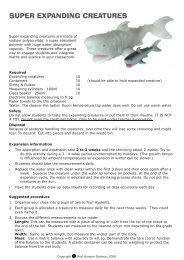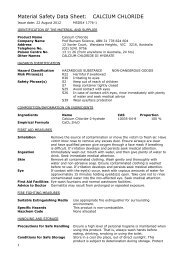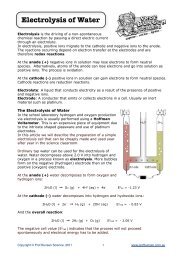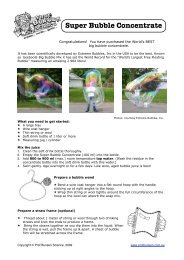Colour Changing Solutions - Prof Bunsen
Colour Changing Solutions - Prof Bunsen
Colour Changing Solutions - Prof Bunsen
You also want an ePaper? Increase the reach of your titles
YUMPU automatically turns print PDFs into web optimized ePapers that Google loves.
<strong>Colour</strong> <strong>Changing</strong> <strong>Solutions</strong>Teaching kitchen chemistry can be fun and exciting as there are a number of readily availableacid-base indicators in the kitchen that will demonstrate some vivid colour changes. Inanother writing we have covered turmeric powder and toy shop disappearing ink.Red cabbage or purple cabbage is another acid-base indicator compound. The colored pigmentin red cabbage is one of a number of naturally occurring acid-base indicator dyes (another islitmus, which is extracted from a lichen). The red color of cabbage comes from a moleculeknown as anthocyanin. Like other indicator dyes, the structure of the molecule changes in itsacid or base form.Many foods contain anthocyanins including cranberry juice, black currants, and strawberries aswell as many flowers.Extraction:1. Take a few red cabbage leaves and cut them intosmall pieces. Even better, put them through ablender.2. Fill a small pot / saucepan about three-fourthswith the cabbage pieces, and add tap water.3. Place the pot on the stove and simmer for 5minutes. Do not let too much water evaporate sothe cabbage burns.4. Remove the pot when you have a dark purpleextract.5. Pour the cabbage extract indicator solution into alabelled stock bottle. If you are going to keep thesolution for a while, store it in the refrigerator.Alternatively you may want to purchase our stable Red cabbage colour crystals. Long lastingand available when required!Make your own pH test strips• Place a few coffee filter papers or lab filter papers in the concentrated extract for 20 minutes.It is important to use concentrated extract to ensure vivid colour changes.• Remove the papers and leave to dry. Cut them into strips that can be used by students toindicate the pH (acidity) of household items such as milk, vinegar, oil, soft drinks and more.Below are the pH values and corresponding colours for red cabbage.If you know your chemistry then you can prepare a range of pH solutions using hydrochloricacid and a base from a pH of 1 to 12. You can then set up your own indicator chart, such asthis one by www.braukaiser.com:Copyright © <strong>Prof</strong> <strong>Bunsen</strong> Science, 2012 1 www.profbunsen.com.au
Change colours magically by manipulating the pH values of the solutions1. Start with three clean, clear glasses and use clean tap water.2. Purchase citric acid and caustic soda from the supermarket. See images below.3. Add some red cabbage extract to glass no 1. Sprinkle a few crystals of citric acid to glassno 2 and a few crystals of caustic soda to glass no 3. (Careful: Wear safety glasses.Caustic soda can cause burns and skin irritation. Not for student use!)4. Here is the Show part: Pour water in glass no 1 and announce that you can turn water intogrape juice! Blue5. Now convince the audience that you can turn grape juice into strawberry juice. Pour theliquid from glass 1 to glass 2 : blue --> pink6. Now announce the transition of strawberry juice to lime juice and pour the solution fromglass no 2 to glass no 3: pink ---> green7. Is this a reversible chemical process? Yes. Add some vinegar or citric acid to the greensolution and stir: green ---> pink A few caustic soda crystals will turn the solution backto green on stirring. Students just love this simple but effective colour change! Try it!Additional things to do• Using a straw, breathe in deeply, and then slowly bubble your exhaled breath through a ⅓full glass of the blue (neutral) solution. (CO2 forms weak carbonic acid that pushes the pH toa lower value --> pink) Make sure students do not suck but only blow into the solution.• Let students draw up a table with ordinary household ingredients and have them measureand evaluate the acidity using the test strips. Use milk, solutions of salt, sugar, sodiumbicarbonate, vinegar, hand soap, Sprite or lemonade, oil, etc.---------------------------------Copyright © <strong>Prof</strong> <strong>Bunsen</strong> Science, 2012 2 www.profbunsen.com.au


